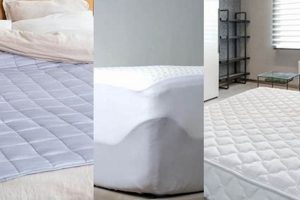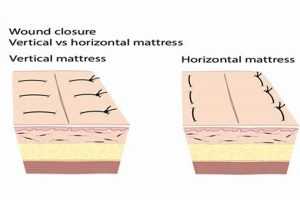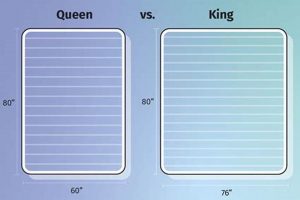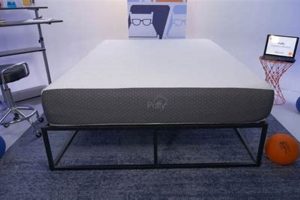The discussion centers around the dimensional disparities between mattresses marketed as “RV queen” and those sold as “regular queen.” RV queen mattresses typically feature a shorter length compared to standard queen mattresses. A regular queen mattress usually measures 60 inches wide by 80 inches long, while an RV queen mattress often maintains the 60-inch width but reduces the length to 75 inches or even 74 inches in some instances. This size variation is crucial when selecting bedding for recreational vehicles.
The impetus for the smaller RV queen mattress stems from the spatial constraints inherent in recreational vehicles. Optimizing interior space is paramount in RV design; therefore, manufacturers frequently opt for shorter mattresses to maximize maneuverability within the living area and bedroom. This dimensional accommodation allows for more efficient use of limited square footage without compromising sleeping space excessively. Consideration of these size variations is vital for RV owners when purchasing replacement mattresses or bedding.
Understanding the distinctions in dimensions is just the beginning. The ensuing discussion will delve into the practical implications of these size differences, material considerations, and factors to consider when choosing between the two options. Factors like comfort, support, and the specific layout of the recreational vehicle will influence the optimal mattress selection.
Essential Considerations for RV Queen vs. Regular Queen Mattress Selection
This section provides crucial guidance to ensure an informed decision when choosing between an RV queen and a regular queen mattress. These considerations will assist in optimizing comfort and functionality within the recreational vehicle.
Tip 1: Measure the Available Space Accurately: Before any purchase, meticulously measure the designated mattress area within the RV. Factor in any obstructions or limitations that may affect the suitability of a standard queen mattress.
Tip 2: Prioritize Spatial Efficiency: Recognize that RVs prioritize spatial economy. The shorter length of an RV queen mattress contributes to improved maneuverability and maximizes usable living space.
Tip 3: Consider Sleeping Preferences: Individuals taller than average may find the shorter RV queen mattress restrictive. A regular queen mattress, if space permits, offers enhanced legroom and overall comfort.
Tip 4: Evaluate Mattress Material and Support: Regardless of size, mattress material dictates comfort and support. Memory foam, latex, and innerspring options are available in both RV queen and regular queen sizes. Choose based on individual comfort needs.
Tip 5: Assess Mattress Weight: RVs have weight limitations. A heavier mattress can impact fuel efficiency and overall vehicle performance. Opt for lighter materials if weight is a significant concern.
Tip 6: Check Bedding Availability: RV queen-sized bedding may be less readily available than standard queen bedding. Factor in the cost and accessibility of appropriately sized sheets, blankets, and mattress protectors.
Tip 7: Factor in Cost: Price points vary depending on the size, material, and brand. Compare prices of both RV queen and regular queen mattresses, considering long-term value and potential replacement costs.
By carefully weighing these factors, prospective buyers can mitigate potential issues and ensure that the chosen mattress provides optimal comfort and functionality within the unique environment of a recreational vehicle. Careful measurement and consideration of individual needs are paramount.
The next section will outline the long-term implications of this selection, providing a detailed comparison and concluding thoughts on optimizing sleep quality in an RV setting.
1. Length differential
The “length differential” is a foundational element in the discussion of RV queen versus regular queen mattresses. This difference in length, typically ranging from five to six inches, directly impacts the suitability and usability of each mattress type within the confines of a recreational vehicle.
- Space Optimization in RVs
The primary advantage of the reduced length in an RV queen mattress is space optimization. Recreational vehicles prioritize efficient utilization of limited square footage. The shortened mattress allows for improved maneuverability within the bedroom area, creating more functional living space. This is particularly relevant in smaller RV models where every inch counts. For example, a five-inch reduction in length can free up valuable space for wardrobe storage or improved access to adjacent living areas.
- Impact on Sleeping Comfort
The length differential directly affects sleeping comfort, particularly for taller individuals. A regular queen mattress, with its standard 80-inch length, provides ample legroom for most adults. However, the shorter RV queen mattress (typically 74-75 inches) may cause discomfort for individuals exceeding six feet in height, leading to potential sleep disturbances or postural issues. This necessitates careful consideration of individual height and sleeping preferences when selecting a mattress for an RV.
- Bedding Compatibility Issues
The length differential creates challenges with bedding compatibility. Standard queen-sized sheets, designed for an 80-inch mattress, will be excessively long when used with an RV queen mattress. This can result in ill-fitting sheets that bunch up, creating discomfort and aesthetic issues. RV owners must either purchase specialized RV queen-sized bedding (which may be less readily available and potentially more expensive) or adapt standard queen sheets through alterations.
- Resale Value Considerations
The choice between an RV queen and regular queen mattress can subtly influence the resale value of a recreational vehicle. While a regular queen mattress might be perceived as more desirable by some buyers due to its enhanced sleeping comfort, its suitability depends heavily on the RV’s specific layout and spatial constraints. If installing a regular queen compromises functionality, it may detract from the vehicle’s appeal. Conversely, an RV queen mattress that perfectly fits the available space demonstrates thoughtful design and may be viewed more favorably.
In conclusion, the length differential is a critical factor when considering RV queen versus regular queen mattresses. It represents a trade-off between space optimization, sleeping comfort, bedding compatibility, and potential resale value. Understanding these interdependencies is crucial for RV owners seeking to maximize the functionality and livability of their mobile living space. The optimal choice hinges on carefully assessing individual needs, spatial limitations, and long-term considerations.
2. Space optimization
Space optimization is a primary concern within recreational vehicles (RVs). The choice between an RV queen and a regular queen mattress directly impacts the effective use of available interior area. Understanding this relationship is crucial for maximizing comfort and functionality within the limited confines of an RV.
- Reduced Mattress Length and Walkway Clearance
The shorter length of an RV queen mattress, typically 74-75 inches compared to the standard queen’s 80 inches, translates directly into increased walkway clearance. This added space facilitates easier movement around the bed, preventing obstructions and enhancing accessibility to other areas of the RV, such as closets or bathroom facilities. For instance, in a compact RV bedroom, five to six inches of additional walkway space can significantly improve maneuverability and reduce the feeling of confinement.
- Enhanced Storage Accessibility
In many RV designs, under-bed storage is a crucial component of the overall storage solution. The reduced length of an RV queen mattress can enhance accessibility to these storage compartments. Easier access allows for more efficient organization and retrieval of stored items, maximizing the utility of the available space. A regular queen mattress might partially obstruct access, making it more cumbersome to reach items stored beneath the bed.
- Flexibility in Bedroom Layout
The space saved by utilizing an RV queen mattress provides greater flexibility in designing the overall bedroom layout. This additional space can be used to accommodate other essential features, such as nightstands, small wardrobes, or even a dedicated workspace. This adaptability allows RV owners to customize the living space to suit their individual needs and preferences, creating a more functional and comfortable environment.
- Impact on Overall RV Design and Functionality
The choice of mattress size is not an isolated decision; it influences the broader design and functionality of the RV. Manufacturers consider mattress dimensions when designing interior layouts, and opting for a standard queen mattress may necessitate compromises in other areas, such as reduced living space or smaller bathroom facilities. Selecting an RV queen mattress allows for a more harmonious balance between sleeping area and other essential functions, ensuring the overall design remains coherent and efficient.
In summary, space optimization is a central consideration when evaluating RV queen versus regular queen mattresses. The reduced length of the RV queen offers tangible benefits in terms of walkway clearance, storage accessibility, bedroom layout flexibility, and overall RV design coherence. These factors contribute significantly to enhancing the livability and functionality of a recreational vehicle, underscoring the importance of carefully assessing spatial constraints when making a mattress selection.
3. Bedding compatibility
Bedding compatibility emerges as a significant consideration when comparing RV queen and regular queen mattresses. The dimensional disparity between these mattress types necessitates a careful evaluation of available bedding options to ensure a proper fit and optimal comfort.
- Standard Queen Bedding Dimensions
Standard queen-sized bedding, designed for mattresses measuring 60 inches wide by 80 inches long, presents a challenge when used with RV queen mattresses, which are typically shorter in length (74-75 inches). Fitted sheets, flat sheets, and comforters intended for a standard queen will have excess fabric when used on an RV queen, potentially leading to bunching, discomfort, and an unkempt appearance. This incompatibility demands specific solutions.
- Availability of RV Queen-Sized Bedding
RV queen-sized bedding represents a potential solution; however, its availability is often limited compared to standard queen options. Retailers may offer fewer choices in terms of style, material, and price point for RV queen bedding. This limited availability may require RV owners to seek out specialized suppliers or consider custom-made bedding, which can increase costs. Moreover, the color and pattern selection may be less extensive than that for standard queen bedding.
- Altering Standard Bedding
Altering standard queen bedding to fit an RV queen mattress provides a viable alternative. Modifying fitted sheets and flat sheets to remove excess fabric can create a more tailored fit. This approach requires basic sewing skills or the services of a professional tailor. While altering bedding can be cost-effective, it also demands time and effort. Furthermore, alterations may not always achieve a perfectly seamless fit, potentially impacting comfort and aesthetics.
- Using Adjustable Bedding Components
Employing bedding components with adjustable features can mitigate some of the compatibility issues. Fitted sheets with elasticized edges and deep pockets can accommodate a range of mattress thicknesses and lengths. Similarly, duvet covers with adjustable closures can provide a more tailored fit for different mattress sizes. While adjustable components offer some flexibility, they may not completely resolve the fit issues associated with using standard queen bedding on an RV queen mattress.
In conclusion, bedding compatibility represents a crucial consideration when choosing between an RV queen and regular queen mattress. The dimensional differences necessitate careful planning and potentially specialized purchases or alterations to ensure a proper fit and comfortable sleeping experience. Weighing the availability, cost, and effort associated with bedding solutions is essential for making an informed decision that optimizes both comfort and practicality within the RV environment.
4. Sleeping comfort
Sleeping comfort is intrinsically linked to the dimensional characteristics of an RV queen versus a regular queen mattress. The size of the mattress directly impacts the quality of rest experienced within the confined space of a recreational vehicle. A mattress that is either too short or lacking adequate support can lead to disrupted sleep cycles, physical discomfort, and long-term health implications. For instance, an individual taller than six feet sleeping on an RV queen mattress, which is typically 74-75 inches in length, may experience restricted legroom. This restriction can lead to restless sleep as the individual attempts to find a comfortable position. The impact on sleeping comfort underscores the importance of considering personal height and sleeping habits when selecting a mattress for RV use.
The material composition of the mattress further influences sleeping comfort. Regardless of whether an RV queen or regular queen size is chosen, the mattress should provide adequate support and pressure relief. Memory foam, latex, and hybrid models offer varying degrees of comfort and support. A mattress that is too firm can lead to pressure points and discomfort, while one that is too soft may lack adequate spinal support. Therefore, understanding the interplay between mattress size and material composition is essential for optimizing sleeping comfort within the unique environment of an RV. Consider, for example, the long-distance traveler who spends multiple nights per week in their RV; consistent lack of proper support could exacerbate pre-existing back problems.
In summary, the relationship between sleeping comfort and mattress size in an RV setting is multifaceted. The physical dimensions of the mattress must accommodate the individual’s height and sleeping preferences, while the material composition must provide adequate support and pressure relief. Balancing these factors is critical for achieving restful sleep and mitigating potential long-term health consequences. Selecting the correct mattress, tailored to the specific constraints and demands of RV travel, is paramount.
5. Vehicle constraints
Vehicle constraints, encompassing spatial limitations, weight restrictions, and layout configurations, directly dictate the feasibility of incorporating either an RV queen or a regular queen mattress within a recreational vehicle. The interplay between these constraints and mattress dimensions significantly influences the overall functionality and comfort of the living space.
- Spatial Limitations
The interior dimensions of an RV often preclude the installation of a standard-sized queen mattress. RVs, particularly smaller models, are designed with limited square footage, necessitating the use of a shorter RV queen mattress (typically 74-75 inches) to preserve walkway space and maneuverability. Attempting to install a regular queen (80 inches) can lead to obstructed pathways and compromised accessibility to other areas of the vehicle. For example, an older, compact RV model may simply not have the required length to accommodate a standard queen without blocking entryways or essential storage areas.
- Weight Restrictions
Weight limitations are a critical factor in RV design and operation. Exceeding the vehicle’s maximum weight capacity can compromise fuel efficiency, handling, and overall safety. Mattresses contribute significantly to the total weight, and the density of materials used (e.g., memory foam, innerspring) further influences this factor. A regular queen mattress, due to its larger size and often greater material volume, tends to weigh more than an RV queen mattress. This weight difference, while seemingly minor, can contribute to exceeding weight limits, especially when combined with other onboard items and passengers. For instance, a family preparing for a long trip might inadvertently overload their RV by overlooking the added weight of a heavier mattress.
- Layout Configurations
The internal layout of an RV, including the placement of the bedroom area, storage compartments, and other amenities, significantly impacts mattress selection. Some RV designs incorporate built-in bed platforms or storage compartments that are specifically sized for an RV queen mattress. Adapting such a design to accommodate a regular queen mattress may require costly and complex modifications to the existing structure. Conversely, some larger, more luxurious RV models may be designed with sufficient space to comfortably accommodate a standard queen without compromising functionality. An illustrative example is an RV with a slide-out bedroom area; the extended space may readily house a regular queen, making it a more desirable choice in terms of comfort.
- Doorway and Hatchway Dimensions
While less frequently considered, the dimensions of doorways and hatchways within the RV can present a logistical challenge during mattress installation or replacement. A regular queen mattress may be too large to maneuver through these openings, necessitating careful planning and potentially awkward maneuvering. An RV queen, with its slightly smaller footprint, typically offers a more manageable installation process. This is particularly relevant when replacing an existing mattress, as the original mattress was likely chosen with these access points in mind. Consider the difficulty of trying to install a bulky, standard queen mattress into a vintage RV with narrow doorways; an RV queen might be the only viable option without significant modifications to the vehicle itself.
In conclusion, the selection between an RV queen and a regular queen mattress hinges critically on a thorough assessment of vehicle constraints. Spatial limitations, weight restrictions, layout configurations, and doorway dimensions collectively determine the suitability of each mattress type. Prioritizing these constraints ensures not only comfortable sleeping arrangements but also the safe and efficient operation of the recreational vehicle.
Frequently Asked Questions
The following questions address common concerns and misconceptions regarding the dimensional differences and practical implications of selecting an RV queen versus a regular queen mattress.
Question 1: What are the precise dimensions of an RV queen mattress compared to a regular queen mattress?
A regular queen mattress typically measures 60 inches wide by 80 inches long. An RV queen mattress commonly maintains the 60-inch width but reduces the length to approximately 74 or 75 inches. Exact dimensions may vary slightly by manufacturer.
Question 2: Why is the RV queen mattress shorter than a regular queen mattress?
The reduced length of the RV queen mattress is primarily intended to optimize space utilization within the confined interiors of recreational vehicles. Shorter mattresses provide improved maneuverability and maximize usable living area.
Question 3: Can standard queen-sized bedding be used on an RV queen mattress?
Standard queen-sized bedding is not ideally suited for RV queen mattresses due to the length discrepancy. Excess fabric can result in ill-fitting sheets that bunch up and create discomfort. RV queen-sized bedding or alterations to standard bedding are recommended.
Question 4: Are RV queen mattresses less comfortable than regular queen mattresses?
Comfort is subjective and depends on individual preferences. The shorter length of an RV queen mattress may be less comfortable for taller individuals. Mattress material and construction are also significant factors in overall comfort.
Question 5: Does using an RV queen mattress negatively impact the resale value of a recreational vehicle?
The impact on resale value is variable. While a regular queen mattress might be perceived as more desirable by some buyers, its suitability depends on the RV’s layout and spatial constraints. An RV queen mattress that fits the available space effectively can be a positive selling point.
Question 6: Where can one purchase RV queen-sized mattresses and bedding?
RV queen mattresses and bedding can be found at specialized RV supply stores, online retailers, and some larger mattress retailers. Selection and availability may be more limited compared to standard queen sizes.
Choosing between an RV queen and regular queen mattress involves a careful assessment of spatial limitations, comfort preferences, and bedding options. The optimal selection is contingent upon the specific requirements of the recreational vehicle and its occupants.
The following section addresses specific scenarios to help guide mattress selections.
RV Queen Mattress Size vs Regular Queen Mattress
This exploration of “rv queen mattress size vs regular queen mattress” has illuminated the critical dimensional differences and their practical implications for recreational vehicle owners. Spatial constraints, bedding compatibility, and sleeping comfort are key determinants in selecting the appropriate mattress. While a regular queen offers familiar dimensions, its suitability within the limited confines of an RV is often compromised. The RV queen mattress, though shorter, frequently provides a more practical solution for optimizing space and maneuverability within the vehicle.
The decision to choose an RV queen over a regular queen requires careful consideration of individual needs and the specific parameters of the recreational vehicle. By weighing the trade-offs between space optimization and sleeping comfort, a well-informed decision can ensure both a comfortable and functional living environment. Future innovations in mattress design may further bridge the gap between space efficiency and sleeping quality, but for now, a diligent assessment of requirements remains paramount.







